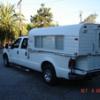Hey, PackRat~ Thanks for your thorough explanation! Yes, I am feeling better, though not back to normal yet. This cold is really hanging on. Anyway, I had occasion to drive the truck a couple weeks ago, and was amazed that the camper bounced up in the truck on a very small speed bump, so I'm definitely looking for a way to cinch it down. I saw some bolts under the floor that looked like they were supposed to bolt into the walls of the truck bed. I didn't get photos of them today, but my first impression is that didn't seem like enough at all for preventing that bounce. I will have to investigate this more. Luckily, the truck is not my daily driver, so I have a little time to get it sorted out.
****************
Now I have a question that seems almost too basic to be asking, but I want to make sure I am understanding correctly. In order to drain hydraulic fluid and replace O-rings, I'm going to have to remove the rams from the camper, correct? What I saw looked like each ram is held in place by the brass fitting that connects the lines to the bottom of the rams, and by two metal straps that keep the ram in the correct position. The top of the ram fits under the angle bracket that lifts the camper top when the hydraulic fluid is pumped up into the rams, right? I couldn't tell on the one I was looking at ( in the back corner closet) whether the ram actually is bolted into that bracket or not. I want to make sure before I start taking things apart that it's going to be easier to replace the o-rings with the ram out of the camper. I can't quite imagine how I would do it with the rams in place, but you never know.
So, first I need to drain out all the fluid, right? (I saw directions on how to do that in another thread). After all the fluid is drained, I take out each ram so I can clean and replace o-rings, right? The only fitting I could find was on the very bottom of the ram:
So when you guys talk about loosening the fitting to drain fluid, you're talking about the compression fitting shown here, right?
Like I have said before, I'm reasonably handy, but this system is all new to me.....














